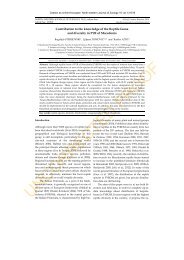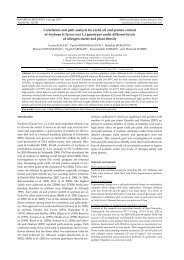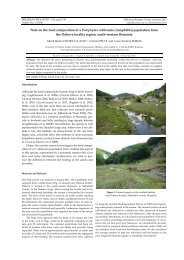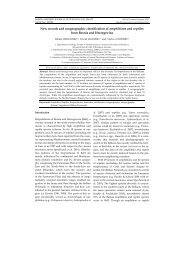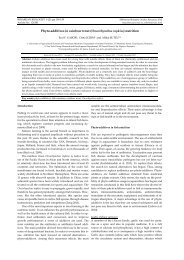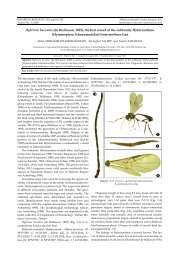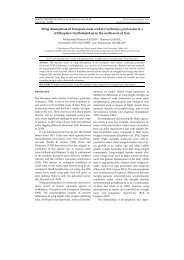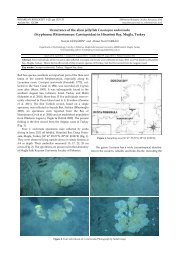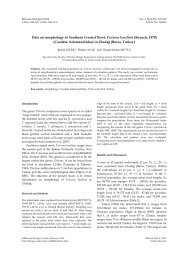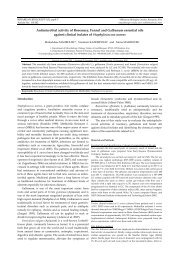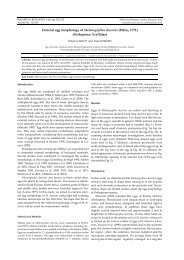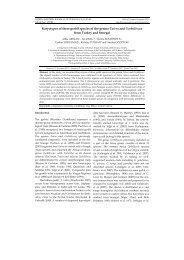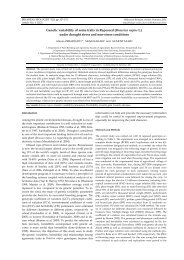Evaluation of seed storage protein patterns of ten wheat varieties ...
Evaluation of seed storage protein patterns of ten wheat varieties ...
Evaluation of seed storage protein patterns of ten wheat varieties ...
Create successful ePaper yourself
Turn your PDF publications into a flip-book with our unique Google optimized e-Paper software.
BIHAREAN BIOLOGIST 5(2): pp.116-118 ©Biharean Biologist, Oradea, Romania, 2011<br />
Article No.: 111118 http://biologie-oradea.xhost.ro/BihBiol/index.html<br />
<strong>Evaluation</strong> <strong>of</strong> <strong>seed</strong> <strong>storage</strong> <strong>protein</strong> <strong>patterns</strong> <strong>of</strong> <strong>ten</strong> <strong>wheat</strong> <strong>varieties</strong> using SDS-PAGE<br />
Mehdi KAKAEI 1,* and Danial KAHRIZI 2,3<br />
1. Agriculture (Genetic and Plant Breeding) Department, Payame Noor University, 19395-4697 Tehran, I. R. <strong>of</strong> Iran.<br />
2. Biotechnology for Drought Resistance Research Department, Razi University, Kermanshah, Iran.<br />
3. Medical Biology Research Center, Kermanshah University <strong>of</strong> Medical Sciences, Kermanshah, Iran.<br />
* Corresponding author, M. Kakaei, E-mail: Mehdikakaei@yahoo.com or M_Kakaei@pnu.ac.ir,<br />
Phone: +98 812 322 4050 (Office); +98 918 816 2875 (Mobile).<br />
Received: 27. February 2011 / Accepted: 14. August 2011 / Available online: 15. August 2011<br />
Abstract. SDS-PAGE was used to evaluate and characterize the <strong>patterns</strong> <strong>of</strong> <strong>seed</strong> <strong>storage</strong> <strong>protein</strong>s in <strong>ten</strong> bread <strong>wheat</strong> (Triticum<br />
aestivum L.) genotypes. Electrophorogram for each variety were scored for presence/absence in each sample, which were<br />
transformed into a binary data matrix. Jaccard΄s similarity coefficient, generated to determine the genetic similarity among<br />
genotypes, revealed that most <strong>of</strong> the genotypes were genetically distant from each other. The cluster analysis with UPGMA<br />
method separated the genotypes into 2 clusters. Based on Jaccard's similarity matrix, we represented a <strong>protein</strong> marker and it is<br />
clear that genotype 14GB & Hama-4, 14GB & un11 and Hama-4 & un11 have the highest similarity and lowest genetic distance.<br />
Genotypes Boomaz and Saji have the least similarity and maximum distance.<br />
Key Words: Triticum aestivum, <strong>protein</strong> <strong>patterns</strong>, SDS-PAGE, Cluster analysis.<br />
Introduction<br />
Wheat (Triticum aestivum L.) is considered as one <strong>of</strong> the most<br />
primitive domesticated crop. Bread <strong>wheat</strong> plays a major role<br />
among the few crop species being widely grown as food<br />
sources and was likely a central point to the beginning <strong>of</strong> agriculture<br />
(Shuaib et al. 2007). One practical application <strong>of</strong><br />
knowledge <strong>of</strong> genetic diversity is in the design <strong>of</strong> populations<br />
for genome mapping experiments (Kaga et al. 1996).<br />
Seem concluded that <strong>seed</strong> <strong>storage</strong> <strong>protein</strong> pr<strong>of</strong>iles could be<br />
useful markers in the studies <strong>of</strong> genetic diversity and classification<br />
<strong>of</strong> genotypes. The morphological markers were not<br />
quite enough to expose the genetic diversity between the<br />
morphological overlap cultivars and the morphological<br />
identical accessions. Therefore, the need for a new tool was<br />
disparate. The advent <strong>of</strong> the electrophoretical as an analytical<br />
tool provides an indirect method for genome probing by<br />
exposing structural variations in enzymes or other <strong>protein</strong><br />
genome (Cook 1984, Gilliand 1989). Wheat (Triticum aestivum<br />
L.) <strong>seed</strong>-<strong>storage</strong> <strong>protein</strong>s represent an important source <strong>of</strong><br />
food and energy, being also involved in the determination <strong>of</strong><br />
bread-making quality (Cooke & Law 1998). Plant <strong>storage</strong><br />
<strong>protein</strong>s in general and <strong>wheat</strong> <strong>storage</strong> <strong>protein</strong>s in particular<br />
contribute to the major source <strong>of</strong> the required nutritional<br />
<strong>protein</strong> and carbohydrates to nearly all nations around the<br />
globe (Izadi–Darbandi et al. 2010). The most common cultivated<br />
<strong>wheat</strong> nowadays is hexaploid T. aestivum, AABBDD,<br />
(2n= 6X= 42) (Zohary & Hopf 1993). Acrylamide gel electrophoresis<br />
in the presence <strong>of</strong> sodium dodecyl sulfate has become<br />
one <strong>of</strong> the most widely used techniques to separate<br />
and characterize <strong>wheat</strong> <strong>storage</strong> <strong>protein</strong>s (Shuaib et al. 2010).<br />
SDS-PAGE could be conveniently used for identification <strong>of</strong><br />
<strong>wheat</strong> <strong>varieties</strong> suitable for chapatti making (Prabhasankar<br />
& Rao 2001). Seed <strong>storage</strong> <strong>protein</strong>s have been used as genetic<br />
markers in four major areas: (1) analysis <strong>of</strong> genetic diversity<br />
within and between accessions, (2) plant domestication in relation<br />
to genetic resource conservation and breeding, (3) establishing<br />
genome relationships, and (4) as a tool in crop<br />
improvement (Ghafoor & Ahmad 2005). Studying <strong>of</strong> <strong>storage</strong><br />
<strong>protein</strong>s has been reported in many researches such as phylogenetic<br />
relationships, genomic homologies and genetic di-<br />
versity (Lufiudra & Benedetelli 1985). These are considered<br />
as practical and reliable methods because <strong>seed</strong> <strong>storage</strong> <strong>protein</strong>s<br />
and nucleotide sequences are largely independent <strong>of</strong><br />
environmental fluctuations (Iqbal et al. 2005). The aim <strong>of</strong> the<br />
present paper was to study the genetic diversity <strong>of</strong> <strong>wheat</strong> on<br />
the basis that SDS-PAGE may provide useful information for<br />
the use <strong>of</strong> genotypes in different breeding experiments.<br />
Materials and Methods<br />
The present study used 10 <strong>wheat</strong> genotypes (Table 1) that prepared<br />
from Dryland Agricultural Research Institute, Kermanshah, Iran. To<br />
extract total <strong>protein</strong>s, single grain powder was added with <strong>protein</strong><br />
extraction buffer (Tris-Hcl, pH=8.5; NP-40, 0.2%; PMSF, 1mM and<br />
EDTA, 1mM) vortex and gently shaken overnight, centrifuged at<br />
12,500 rpm for 15 minutes, following the method described by Xi<br />
and collaborators (2006) with some modifications (Kakaei et al. 2010).<br />
SDS-PAGE method in resolving gel with 12.5% acrylamid and stacking<br />
gel 5% acrylamid was applied for extraction and resolving <strong>of</strong><br />
these genotypes. Then, after gel electrophoresis, <strong>protein</strong> bands were<br />
revealed by Coomassie Brilliant Blue R-250 staining and destained<br />
by methanol and acetic acid. Dissociating polyacrylamide gel electrophoresis<br />
(SDS-PAGE) was adopted after Laemmli (1970) with<br />
some modifications. Protein assay was made according to Bradford<br />
(1976). The molecular weight <strong>of</strong> each band was identified by the<br />
standard curve obtained from the standard <strong>protein</strong>s. Standard <strong>protein</strong>s<br />
were used and their molecular weights were: ovotransferrin (78<br />
kDa), bovine serum albumin (66 kDa), ovalbumin (45 kDa), actinidin<br />
(29 kDa), β lactoglobulin (18 kDa) and lysozyme (14 kDa).<br />
Table 1. The <strong>wheat</strong> genotypes that have been used in study<br />
<strong>of</strong> <strong>seed</strong> <strong>protein</strong>s pattern are divided in two groups.<br />
No. Genotypes<br />
name<br />
Genome Cluster<br />
No.<br />
1 Azar-2 AABBDD 1<br />
2 ww33G AABBDD 2<br />
3 14GB (Awhadi) AABBDD 2<br />
4 Pato AABBDD 2<br />
5 Boomaz AABBDD 2<br />
6 Shahi AABBDD 2<br />
7 Hama-4 AABBDD 2<br />
8 Un11 AABBDD 2<br />
9 Cross Alborz AABBDD 2<br />
10 Saji AABB 1
<strong>Evaluation</strong> <strong>of</strong> <strong>seed</strong> <strong>storage</strong> <strong>protein</strong> <strong>patterns</strong> <strong>of</strong> <strong>ten</strong> <strong>wheat</strong> <strong>varieties</strong> using SDS-PAGE<br />
Cluster analysis<br />
Cluster analysis <strong>of</strong> <strong>wheat</strong> grain <strong>storage</strong> <strong>protein</strong>s was performed on<br />
the results <strong>of</strong> SDS-PAGE using the s<strong>of</strong>tware NTSYS to find out the<br />
diversity among the given <strong>wheat</strong> <strong>varieties</strong>.<br />
Data analysis<br />
Electrophoregrams for each cultivar were scored and the presence (1)<br />
or absence (0) <strong>of</strong> each band noted. Presence and absence <strong>of</strong> bands<br />
were entered in a binary data matrix. Based on electrophoresis band<br />
spectra, Jaccard‘s similarity index.<br />
Results and Discussion<br />
Electrophorogram showing <strong>protein</strong>s banding pattern <strong>of</strong> different<br />
<strong>wheat</strong> <strong>varieties</strong> was presented in Fig.1. Based on the<br />
results, it is concluded that evaluation <strong>of</strong> genetic diversity<br />
and identification <strong>of</strong> <strong>wheat</strong> <strong>varieties</strong> by SDS-PAGE is easy, if<br />
early approached and useful for molecular weight analysis<br />
<strong>of</strong> <strong>wheat</strong> <strong>seed</strong> <strong>storage</strong> <strong>protein</strong>s. The study could help <strong>wheat</strong><br />
breeding programs. The <strong>wheat</strong> genotypes that have been<br />
used in the study <strong>of</strong> <strong>seed</strong> <strong>protein</strong>s pattern are shown in Table<br />
1. The diagram from Fig. 2 revealed two main groups L1<br />
and L2; the group L1 has Azar-2 and Saji and the group L2<br />
has cultivars ww33G, 14GB, Pato, Boomaz, Shani, Hama-4,<br />
Figure 1. Seed <strong>protein</strong> banding pattern <strong>of</strong> T. aestivum<br />
[lane M: Molecular marker others lanes: <strong>wheat</strong> cultivars].<br />
117<br />
un11, Cross Alborz. More differences related to the pattern<br />
<strong>of</strong> <strong>protein</strong> bands were expressed as <strong>protein</strong> bands with molecular<br />
weight ranging from 50 to 78 kDa and the greatest<br />
differences are seen in the expression in<strong>ten</strong>sity and weak<br />
bands in the range <strong>of</strong> less than 18 kDa. SDS-PAGE techniques<br />
are used for studying the genetic diversity in several<br />
researches (S<strong>of</strong>alian & Valizadeh 2009, Kakaei 2009, Kakaei<br />
& Kahrizi 2011, Gantait et al. 2009, Yuzbasioglu 2008,<br />
Solouki & Emamjomeh 2007, Zarkti et al. 2010). Differences<br />
in expression <strong>protein</strong> pattern include the following: In<br />
genotypes 1(Azar-2) and 10 (Saji) the <strong>protein</strong> bands above 66<br />
kDa were removed in a group. Genotypes 2(ww33G),<br />
3(14GB), 6(Shahi) and 8(un11) were near the 19 kDa <strong>protein</strong><br />
band and they are more poorly than other experimental<br />
materials. Fig. 2 shows the resulting dendrogram based on<br />
<strong>protein</strong> Jaccard's coefficient that is <strong>of</strong> r= 0.966, and shows the<br />
data are fitted dendrogram. In Table 2, based on Jaccard's<br />
similarity matrix, it is represented a <strong>protein</strong> marker as is<br />
clear genotype 3(14GB), 7(Hama-4), 3(14GB) & 8(un11) such<br />
as genotypes 7(Hama-4) and 8(un11) with the highest similarity<br />
and the distance is minimal. Genotypes 5 (Boomaz)<br />
and 10 (Saji) have the least similarity and the highest distance.<br />
0.15 0.36 0.58<br />
Coefficient<br />
0.79 1.00<br />
Figure 2. Dendrogram based on <strong>seed</strong> <strong>protein</strong> banding pattern in <strong>wheat</strong>.<br />
C1<br />
C10<br />
C2<br />
C3<br />
C7<br />
C8<br />
C6<br />
C4<br />
C9<br />
C5
118<br />
1<br />
2<br />
3<br />
4<br />
5<br />
6<br />
7<br />
8<br />
9<br />
10<br />
Table 2. Jaccard's similarity matrix based on <strong>seed</strong> <strong>protein</strong> banding pattern.<br />
1<br />
1<br />
0.2<br />
0.2<br />
0.28<br />
0.12<br />
0.15<br />
0.2<br />
0.2<br />
0.22<br />
0.33<br />
2<br />
1<br />
0.8<br />
0.5<br />
0.36<br />
0.75<br />
0.8<br />
0.8<br />
0.54<br />
0.11<br />
3<br />
1<br />
0.66<br />
0.5<br />
0.75<br />
1<br />
1<br />
0.7<br />
0.11<br />
4<br />
1<br />
0.71<br />
0.5<br />
0.66<br />
0.66<br />
0.75<br />
0.16<br />
Experimental results showed that there was no significant<br />
correlation between them. Based on the SDS-PAGE <strong>patterns</strong><br />
all genotypes were classified into three clusters. According<br />
to cultivars distance <strong>of</strong> various groups, parents in two<br />
different extremes may be identified and used in the crossing<br />
projects for generating further variability in order to select<br />
and realize the plant improvement. So, cultivars specific<br />
band(s) that were identified may be exploited for hybrid<br />
identification in breeding program and also which could be<br />
used for the breeder’s needs. Further, we suggest that <strong>seed</strong><br />
<strong>protein</strong> SDS-PAGE be used as a rapid, easy, inexpensive and<br />
reliable method for routine identification <strong>of</strong> Triticum aestivum<br />
genotypes in breeding programs.<br />
Acknowledgements. We wish to thank Kermanshah University <strong>of</strong><br />
Medical Sciences, Medical Biology Research Center for using<br />
laboratory <strong>protein</strong> electrophoresis (Especially Dr. Ali Mostafaei) and<br />
Cereals sector Dryland Agricultureal Reasearch Sub-Institute<br />
Kermanshah (Dr. Reza Haghparast).<br />
References<br />
Bradford, M.M. (1976): A rapid and sensitive method for the quantification <strong>of</strong><br />
microgram quantities <strong>of</strong> <strong>protein</strong> utilizing the principle <strong>of</strong> <strong>protein</strong>-dye<br />
binding. Analytical Biochemistry 72: 248-254.<br />
Cooke, R.J. (1984): The characterization and identification <strong>of</strong> crop cultivars by<br />
electrophoresis. Electrophoresis 5:59-72.<br />
Cooke, R.J., Law, JR. (1998): Seed <strong>storage</strong> <strong>protein</strong> diversity in <strong>wheat</strong> <strong>varieties</strong>.<br />
Plant Varieties and Seeds. 11: 159-167.<br />
Gantait, S., Mandal, N., Das, P.K. (2009): Diversity <strong>of</strong> blackgram (Vigna mungo<br />
L. Hepper) genotypes assessed through morphological and biochemical<br />
approaches. Journal <strong>of</strong> Tropical Agriculture 47(1-2): 80-83.<br />
Ghafoor, A., Ahmad, Z. (2005): Diversity <strong>of</strong> agronomic traits and total <strong>seed</strong><br />
<strong>protein</strong> in black gram vigna mungo (L.) hepper. Acta Biologica Cracoviensia<br />
Series Botanica 47(2): 69-75.<br />
Gilliland, T.J. (1989): Electrophoresis <strong>of</strong> sexually and vegetatively propagated<br />
cultivars <strong>of</strong> allogamous species. Plant Varieties and Seeds 2: 15-25.<br />
Iqbal, S.H., Ghafoor, A., Ayub, N. (2005): Relationship between SDS-PAGE<br />
markers and Ascochyta blight in chickpea. Pakistan Journal <strong>of</strong> Botany 37: 87-<br />
96.<br />
Izadi-darbandi, A., Yazdi-samadi, B., Shanejat-boushehri, A.A., Mohammadi,<br />
M. (2010): Allelic variations in Glu-1 and Glu-3 loci <strong>of</strong> historical and modern<br />
Iranian bread <strong>wheat</strong> (Triticum aestivum L.) cultivars. Indian Academy <strong>of</strong><br />
Sciences, Journal <strong>of</strong> Genetics 89(2): 193-199.<br />
Kaga, A., Tomooka, N., Egawa, Y., Hosaka, K., Kamijima, O. (1996): Species<br />
relationship in the subgenus Ceratotropis (genus Vigna) as revealed by RAPD<br />
analysis. Euphytcia 88: 17-24.<br />
5<br />
1<br />
0.5<br />
0.5<br />
0.5<br />
0.55<br />
0<br />
6<br />
1<br />
0.75<br />
0.75<br />
0.66<br />
0.08<br />
7<br />
1<br />
1<br />
0.7<br />
0.11<br />
8<br />
1<br />
0.7<br />
0.11<br />
9<br />
1<br />
0.12<br />
1<br />
10<br />
Kakaei, M. & Kahrizi, D.<br />
Kakaei, M. (2009): Effects <strong>of</strong> Genotype and drought stress on physiological,<br />
morphological, phonological and biochemical traits <strong>of</strong> winter rape (Brassica<br />
napus L.). M.Sc. Thesis, Islamic Azad University, Branch <strong>of</strong> Kermansha, Iran.<br />
Kakaei, M., Kahrizi, D. (2011): Study <strong>of</strong> <strong>seed</strong> <strong>protein</strong>s pattern <strong>of</strong> brassica napus<br />
<strong>varieties</strong> via sodium dodecyl sulfate polyacrylamid gel electrophoresis.<br />
International Research Journal <strong>of</strong> Biotechnology 2(1): 026-028.<br />
Kakaei, M., Kahrizi, D., Ebadi, A. GH. (2010): Study <strong>of</strong> drought response<br />
extremes <strong>wheat</strong> <strong>varieties</strong> via <strong>seed</strong> <strong>storage</strong> constitutive <strong>protein</strong>s. American<br />
Journal <strong>of</strong> Scientific Research 12: 32-35.<br />
Kakaei, M., Kahrizi, D., Mostafaie, A. (2010): Study on powdery mildew disease<br />
related <strong>protein</strong>s expression in winter <strong>wheat</strong> cultivars via SDS-PAGE.<br />
Biharean Biologist 4(2): 169-171.<br />
Laemmli, U.K. (1970): Cleavage <strong>of</strong> structural <strong>protein</strong>s during the assembly <strong>of</strong><br />
the head <strong>of</strong> bacteriophage T4. Nature 227: 680-685.<br />
Lufiudra, D., Benedetelli, S. (1985): Seed <strong>storage</strong> <strong>protein</strong> and <strong>wheat</strong> genetics one<br />
and two-dimensional (Two pH) polyacryamide gel electrophoresis in a<br />
single gel: separation <strong>of</strong> <strong>wheat</strong> <strong>protein</strong>. Cereal chemistry Journal 62: 314-319.<br />
Prabhasankar, P., Rao, P.H. (2001): Effect <strong>of</strong> different milling methods on<br />
chemical composition <strong>of</strong> whole <strong>wheat</strong> flour. European Food Research and<br />
Technology 213: 465-469.<br />
Shahnejat-Bushehri, A.A., Torabi, S., Omidi, M. Ghannadha, M.R. (2005):<br />
Comparison <strong>of</strong> Genetic and Morphological Distance with Heterosis with<br />
RAPD Markers in Hybrids <strong>of</strong> Barley. International Journal <strong>of</strong> Agriculture &<br />
Biology 4: 592-595.<br />
Shuaib, M., Jamal, M., Akbar, H., Khan, I., Khalid, R. (2010): <strong>Evaluation</strong> <strong>of</strong><br />
<strong>wheat</strong> by polyacrylamide gel Electrophoresis. African Journal <strong>of</strong><br />
Biotechnology 9 (2): 243-247.<br />
Shuaib, M., Zeb, A., Ali, Z., Ali, W., Ahmad, T., Khan, I. (2007):<br />
Characterization <strong>of</strong> <strong>wheat</strong> <strong>varieties</strong> by <strong>seed</strong> <strong>storage</strong> <strong>protein</strong> electrophoresis.<br />
African Journal <strong>of</strong> Biotechnology 6(5): 497-500.<br />
S<strong>of</strong>alian, O., Valizadeh, M. (2009): Investigation <strong>of</strong> Seed Storage Proteins in<br />
some Wild Wheat Progenitors Using SDS-PAGE and ACID-PAGE. Notulae<br />
Botanicae Horti Agrobotanici Cluj-Napoca 37(1): 179-182.<br />
Sokal, R.R., Michener, C.D. (1958): A statistical method for evaluating<br />
systematic relationships. University <strong>of</strong> Kansas Science Bulletin 38: 1409-1438.<br />
Solouki, M., Emamjomeh, A.A. (2007): Determination <strong>of</strong> variations <strong>of</strong> <strong>protein</strong><br />
banding <strong>patterns</strong> <strong>of</strong> high molecular weight-glu<strong>ten</strong>in's subunits in <strong>wheat</strong><br />
after chromosomal substitution. International Journal <strong>of</strong> Biology and<br />
Biomedical Engineering 3(1): 53-56.<br />
Xi, J., Wang, X., Li, S., Zhou, X., Yue, L., Fan, J., Hao, D. (2006): Polyethylene<br />
glycol fractionation improved detection <strong>of</strong> lowabundant <strong>protein</strong>s by twodimensional<br />
electrophoresis analysis <strong>of</strong> plant proteome. Phytochem 67:<br />
2341-2348.<br />
Yuzbasioglu, E., Acik, L., Ozcan, S. (2008): Seed <strong>protein</strong> diversity among lentil<br />
cultivars. Biologia Plantraum 52(1): 126-128.<br />
Zarkti, H., Ouabbou1, H., Taghouti, M., Hilali, A., Udupa, S.M. (2010):<br />
Comparison <strong>of</strong> genetic diversity at prolamin loci in Moroccan durum <strong>wheat</strong><br />
accessions. Plant Omics Journal 3(5):154-158.<br />
Zohary, D., Hopf, M. (1993): Domestication <strong>of</strong> Plants in the old World. Oxford<br />
University Press, Oxford.



